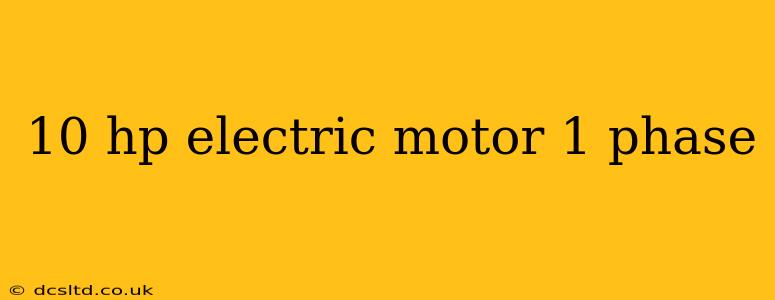Finding the right electric motor for your needs can be challenging, especially when dealing with specific power requirements like a 10 HP single-phase motor. This guide will delve into the specifics of these motors, addressing common questions and providing crucial information for making an informed decision. Whether you're a homeowner tackling a large project or a business owner seeking efficient power solutions, understanding the nuances of 10 HP single-phase motors is key.
What are 10 HP Single-Phase Electric Motors Used For?
10 horsepower single-phase electric motors are powerful units suitable for demanding applications. Their high power output makes them ideal for tasks requiring substantial torque and speed. Common applications include:
- Heavy-duty machinery: Think large woodworking equipment, industrial pumps, and compressors used in workshops or small factories.
- Agricultural equipment: Applications range from grain mills to larger irrigation pumps.
- Construction equipment: Certain smaller construction tools and pumps might utilize this motor size.
- Material handling: Conveyors and lifting equipment in industrial settings sometimes employ 10 HP single-phase motors.
It's crucial to remember that while single-phase power is readily available in homes, the high power draw of a 10 HP motor may necessitate specialized wiring and potentially a dedicated circuit breaker.
Are 10 HP Single-Phase Motors Common?
While less common than their three-phase counterparts, 10 HP single-phase motors are available. However, their prevalence is significantly lower due to several factors:
- Power limitations: Single-phase power supplies inherently have lower current-carrying capacity compared to three-phase systems. This limits the practicality of high-horsepower motors on single-phase circuits.
- Efficiency: Single-phase motors generally have lower efficiency than three-phase motors of the same power rating. This means more energy is lost as heat, leading to higher operating costs.
- Cost: Due to their less common nature and often more complex design, 10 HP single-phase motors may be more expensive than comparable three-phase models.
What are the Advantages and Disadvantages of a 10 HP Single-Phase Motor?
Advantages:
- Widely available power source: Single-phase power is readily available in most homes and some businesses, simplifying installation in certain situations.
- Simplicity of installation (in some cases): The wiring might be simpler than a three-phase system depending on the specific application.
Disadvantages:
- Lower efficiency: Compared to three-phase motors, they're less efficient, resulting in higher energy costs and more heat generation.
- Higher starting current: Single-phase motors often require higher starting current, potentially overloading smaller circuits.
- Limited power output: The 10 HP rating is at the upper limit of what's practical for single-phase power; higher power requirements generally necessitate a three-phase system.
- Higher cost: Generally more expensive than equivalent three-phase motors.
What is the Difference Between a Single-Phase and Three-Phase 10 HP Motor?
The primary difference lies in the power supply and motor design. Three-phase motors are far more efficient, generate less heat, and handle high power demands more readily. Single-phase motors require a simpler power supply but come with compromises in efficiency and power handling capabilities. A three-phase motor is typically the preferred choice for 10 HP applications due to its superior performance. However, access to three-phase power is a crucial determining factor.
How Much Does a 10 HP Single-Phase Electric Motor Cost?
The cost varies considerably depending on the manufacturer, specific features, and the motor's construction (e.g., induction motor vs. capacitor-start motor). Prices can range from several hundred dollars to well over a thousand dollars. It’s best to get quotes from several motor suppliers to compare prices and specifications.
Where Can I Buy a 10 HP Single-Phase Electric Motor?
10 HP single-phase motors can often be sourced from industrial supply companies, electrical motor specialists, and online retailers. It’s crucial to check the specifications carefully to ensure it meets your specific voltage and other requirements before purchasing. Always work with a qualified electrician for installation.
This comprehensive guide provides a solid foundation for understanding 10 HP single-phase electric motors. Remember to consult with professionals to ensure the proper selection, installation, and safe operation of any high-powered electrical equipment. Choosing the right motor is paramount for efficiency, safety, and the longevity of your equipment.
